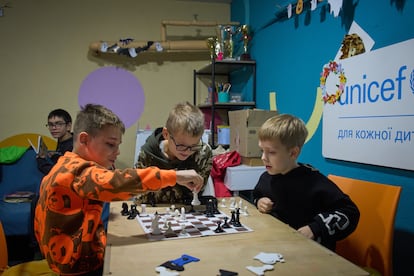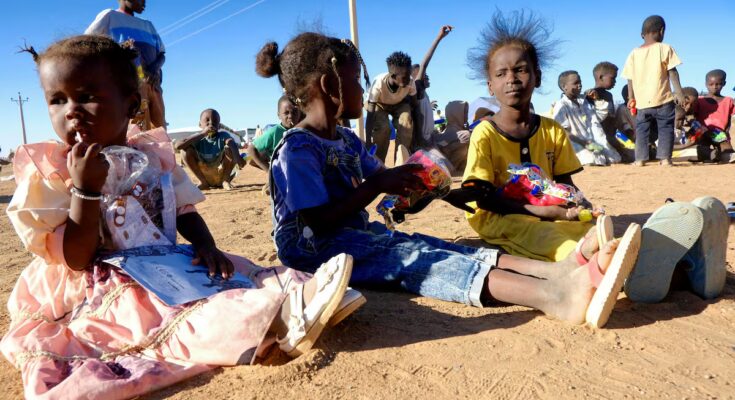When tuberculosis left her father paralyzed, Astride, her siblings and her mother traveled to the copper mines of Lualaba in the Democratic Republic of Congo. For 12 hours of dangerous and exhausting work, collecting and washing ore, this girl received two dollars. “Working in the mine as a woman means living in constant fear,” says Astride, now a welder in the workshop.
His testimony is one of those collected by Unicef in its annual report The state of the world’s children in 2025: Ending child poverty released this Thursday, to coincide with World Children’s Day. In it, the UN agency sends several warning messages: the important progress in the fight against child poverty recorded over the last 25 years has slowed down or even remained stagnant, especially in sub-Saharan African countries, and conflicts, climate damage and serious cuts in official development assistance seriously threaten the fight against child poverty.
“We have the ability to reduce and end child poverty. We must have it as a priority at a national level, because it is proven that when you dedicate will and funds, you get great results, and also as a global priority, which unites us all,” Blanca Carazo, head of international programs at Unicef Spain, tells this newspaper.
We have the ability to reduce and end child poverty
Blanca Carazo, Unicef
This UN agency insists that child poverty is much wider and more serious than lack of money. After examining 130 low- and middle-income countries, the agency estimates that 417 million children, or more than one in five children worldwide, are poor because they are deprived on a daily basis of at least two of the six aspects considered fundamental to their well-being and development: education, health, housing, nutrition, sanitation and water. According to this report, hygiene is the most widespread severe deprivation, with 65% of those lacking access to a toilet in low-income countries.
There are countries where the data is particularly serious, such as Chad, where 64% of boys and girls suffer from significant deficiencies in at least two aspects of this list. But Unicef also highlights success stories such as Tanzania, where poverty was reduced by 46% between 2000 and 2023, thanks largely to public subsidies, and Bangladesh, where there was a 32% decrease thanks to public initiatives to promote education and access to electricity and improve sanitation.
Six million children without school
UNICEF highlights that since 2000 the number of children living in extreme economic poverty has reduced from 507 to 412 million. The coronavirus pandemic has interrupted this positive trend, but in sub-Saharan Africa the setbacks began earlier and, in general, the region has made little or no progress in reducing child poverty since 2014. Currently, more than 19% of children in the world live in extreme economic poverty, that is, on less than three dollars (2.59 euros) a day. Nearly 90% of these children are in sub-Saharan Africa and South Asia.
In high-income countries, although poverty fell by an average of 2.5% across the 37 countries studied between 2013 and 2023, in many cases progress has stalled or reversed. In France, Switzerland and the United Kingdom, for example, child poverty has increased by more than 20% over the same period.
The publication of this report coincides with significant cuts in cooperation by numerous countries, starting with the United States. UNICEF estimates that reductions in official development assistance (ODA) could leave six million children out of school next year.
Reductions in official development assistance (ODA) could leave six million children out of school next year.
A new study from the Barcelona Institute for Global Health (ISGlobal), published this week, estimates that 22.6 million people will die between now and 2030 if these disruptions in global cooperation continue.
“This is not the time to retreat. It is the time to consolidate the progress children have made over the years,” urges Catherine Russell, executive director of Unicef. “There are people who talk about sticking to the basics, which means saving lives, in this time of limited funds. But what about education, with the protection of children? What future awaits them if they become much more exposed to various forms of violence?” asks Carazo.
At the same time, many of the countries most affected by these cuts are highly indebted states, where governments must honor their financial commitments and stop investing in education or healthcare, essential services for children. Unicef highlights that 45 developing countries in the world now pay more in interest than on healthcare and 22 spend more on interest than on education.
In a previous report, UNICEF had already calculated that by 2024 climate damage would cause at least 242 million students in 85 countries to lose access to school.
Sawsan and the wars
Six-year-old Sawsan was injured in an airstrike in eastern Lebanon. The shrapnel entered her head and deprived her of speech, hearing and sight. Furthermore, his house was severely damaged, the family had to move and his father lost his job. The girl has missed a year of school and requires a lot of rehabilitation and therapy. A program launched this year specifically designed to support war-wounded children in Lebanon and funded by the European Union is helping her find some normality.

“There are few images of poverty more powerful than that of a family fleeing and taking with them only what they can carry in a backpack or suitcase,” says Carazo.
UNICEF highlights that in 2024 and 2025 there will be the largest number of countries involved in armed conflicts since the Second World War. In 2024, 19% of the world’s children lived in conflict zones, almost double the percentage recorded in the mid-1990s.
In 2024, 19% of the world’s children lived in conflict zones, almost double the percentage recorded in the mid-1990s.
Furthermore, in 2024, the UN verified more than 41,000 serious violations perpetrated against children in conflict, a figure that represents a 25% increase compared to 2023.
War implies poverty. According to Unicef, more than half of children living in fragile and conflict-affected environments live in conditions of extreme need. Displaced and refugee children are also at greater risk of poverty, during their transit and when they arrive at the place where they find refuge.
Derara and drought in Ethiopia
The family of Derara, a seven-year-old girl, had to emigrate because they were left without a means of subsistence due to the drought. The girl lives today in the Dubuluk refugee camp, under the scorching sun of southern Ethiopia. “We had 25 head of cattle and not a single one survived. We left with nothing. We had no other choice,” explains his mother.
Every year, four in five children face at least one extreme climate risk, which can lead to education disruptions, displacement and deteriorating health.
According to Unicef, around 1 billion children, almost half of the world’s children, live in countries that are at extremely high risk from the impacts of the climate crisis. Every year, four in five children face at least one extreme climate risk, which can lead to education disruptions, displacement and deteriorating health.
“Climate risks and poverty cannot be dissociated. People displaced by drought or flood lose their livelihoods, their lifestyle, their animals…”, underlines Carazo.
According to Unicef, by 2050 up to 175 million people could emerge from extreme poverty through decisive and effective action against climate change. “Tackling poverty and the climate crisis in isolation means missing a huge opportunity,” the report concludes.



